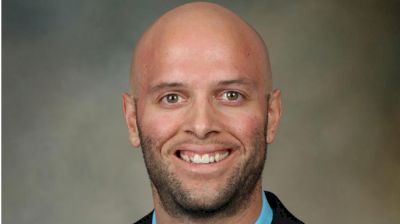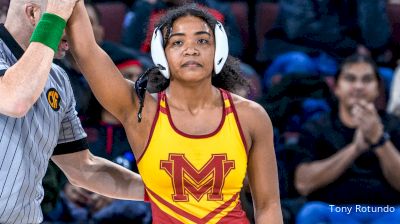Why Did Women's College Weight Classes Change?
Why Did Women's College Weight Classes Change?
Learn more about new weight management procedures for women's college wrestling and hear from coaches about its impact on the sport.

Women’s college wrestling adopted new weight classes for the upcoming season. Here are the previous weights compared to the new ones.
This is a vital policy change with women’s wrestling pushing toward NCAA championship status. Research from the Mayo Clinic’s Health System’s Sports Medicine Research team, led by Dr. Andrew Jagim, produced updated weight management guidelines for the upcoming season.
The biggest change is the minimum body fat thresholds increasing from 12 percent to 17 percent.
Watch the above interview with Dr. Jagim as he covers the following:
— Weight management
— New body fat thresholds (12% to 17% for women)
— New women’s weight classes
— Research from male wrestlers' deaths in the 1990s that led to new weight classes
— India’s Vinesh Phogat missing weight at the Olympics and a possible one-kilogram allowance
— Matside weigh-ins
— Optimal recovery
— Creatine usage
— Sauna usage
— Advice for healthy weight management
Below are highlights from his interview and insights from women’s college coaches about the new weight classes and body fat thresholds.
Jagim On Weight Management
Weight management in the scope of wrestling usually pertains to the weight certification process and how that wrestler, hopefully, manages her weight in the off-season so that it’s not such a shock when it comes time for weight certification. I like to help wrestlers develop a plan in and out of the season so they can hover closer to the weight certification test to set them up for success.
Jagim On The New Body Fat Thresholds
Historically, at the high school and collegiate level, they used a 12 percent threshold for body fat and at the time they didn’t have a good research base to develop that threshold off of. I think they kind of took what the boys and men were doing and just bump it up a little bit.
Since that was established, there were concerns raised that it might be too low for a female wrestler. That might increase risk. Within the last year, at least at the collegiate level, they’ve approved going up to 17 percent as the new threshold that’s used for that formula. It’s preventing some of the collegiate women’s wrestlers from cutting down too low of a body fat percentage.
Jagim On The New Women’s Weight Classes
I wasn’t involved with that decision-making process and how they settled on those specific weight classes. It’s still quite a bit different than what they are doing at the international level so there were questions on why it didn’t try to align better with that. We have to give it another couple of months as programs complete weight certification and start hitting minimum weight classes and see how those numbers look at that point.
Women's College Coaches On New Weights And Procedures
Paulina Biega, Sacred Heart Head Coach
I think it was a good decision to move the minimum body percentage from 12 to 17 percent, especially since very few athletes carry that low percentage of body fat. Our priority should always be the health and safety of our athletes; therefore, I think it’s a step in the right direction.
As far as the new weights, I like the change that was done on the lower end, moving 101 to 103 as the smallest weight class; however, I do not necessarily like the big gaps on the other end when we jump from 160 to 180 to 207. Time and data will tell us more about the righteousness of the new weight classes. Nevertheless, it’s great to see that changes are being made as we try to make our sport better.
Ashley Flavin, Life University Head Coach
Medical professionals recommended the move to 17% minimum body fat to keep our athletes safe. The goal for wrestlers and coaches should always be health and optimal performance, smaller is not always better, and there’s no gold medal for who cuts the most weight.
As coaches, our main priority should be the health and safety of our athletes, not just now, but long term. We can have successful athletes without putting them at risk for injury in the short term and osteoporosis and infertility in the long term. Hopefully, this discourages extreme weight cutting and encourages developing better stronger wrestlers.
This isn’t the first time weight classes have shifted, but it is the first time data has been used to inform the change. It’s going to take a couple of seasons for athletes to find where they perform best at the new weights, but we are all on a level playing field, everyone is making the same adjustment. I think the new weights attempt to honor athletes on both ends of the size spectrum.
Desiree Ramos, William Jewell Head Coach
The body fat threshold is in place to keep from the excessive weight cutting we see across our sport. I think it’s smart for us to be mindful of what healthy is for our female athletes. As far as the change in weight classes, it’s a tricky adjustment for some weights but I understand that it was needed to keep our athletes at optimal weights. I think it’s important for us as coaches to promote healthy weight loss rather than cutting hard because it can have a lifelong impact on our athletes.
Carlene Sluberski, D’Youville Head Coach
The new parameters around minimum body fat percentage for women are designed with health in mind. I think as coaches, our job is to provide our student-athletes the resources to help set them up for success in all areas. Personally, our team didn't run into any issues this year certifying athletes at the weights they want to compete at. As for the new weight classes, the athletes will adjust and figure out where they best fit. Just like they have to adjust to the international weights if they want to compete outside of the collegiate season.
Paul Rademacher, Indiana Tech Head Coach
The 17 percent body fat was part of a study done by the ACSM to determine healthy body fat for female athletes without causing harm to the athlete and their future. Based on their study they determined that the low end should be 17% so we as coaches felt we should put athlete safety over old traditions.
As far as the new weight classes, we looked at the data that the NWCA presented to the ACSM and we needed to adjust the weight classes based on their data presented and the fact that the minimum body fats were going to be adjusted. So the NAIA and NCAA leadership groups worked together to determine some options. Dividing everything by 10% doesn’t work because the middles have differences in weights of only 2-3 pounds, so we worked based on the weight distribution and the OPC to create what we felt was the best-case scenario to keep athletes from having to cut too much weight and also to be able to compete at an optimal performance weight.
Related Content
 Jamilah McBryde vs Aine Drury | 2024 NWCA All-Star Classic Preview
Jamilah McBryde vs Aine Drury | 2024 NWCA All-Star Classic PreviewOct 10, 2024
 Stefana Jelacic vs Kendra Ryan | 2024 NWCA All-Star Classic Preview
Stefana Jelacic vs Kendra Ryan | 2024 NWCA All-Star Classic PreviewOct 8, 2024
 Fargo All-American Olivia Davis A 'Completely Different Wrestler' Entering Super 32
Fargo All-American Olivia Davis A 'Completely Different Wrestler' Entering Super 32Oct 8, 2024
 King University Inducts Iconic 2014 Women's Wrestling Team
King University Inducts Iconic 2014 Women's Wrestling TeamOct 6, 2024
 Is Colorado Mesa On The Cusp Of Best Season In Program History?
Is Colorado Mesa On The Cusp Of Best Season In Program History?Sep 12, 2024
 Women's Wrestling Stars To Collide On WWE Level Up
Women's Wrestling Stars To Collide On WWE Level UpSep 12, 2024
 Will The Running Eagles Soar Like Never Before?
Will The Running Eagles Soar Like Never Before?Sep 8, 2024
 Get To Know Your 2024 U20 Women's Freestyle World Team
Get To Know Your 2024 U20 Women's Freestyle World TeamAug 28, 2024
 Ashley Flavin Brings Life To Women's Wrestling
Ashley Flavin Brings Life To Women's WrestlingJul 28, 2024